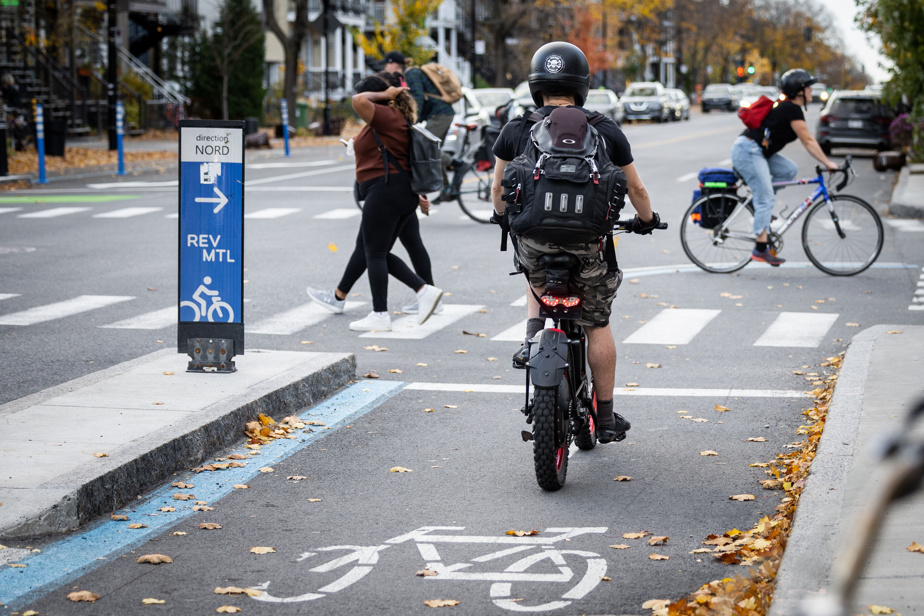(Québec) No sooner had he returned from a mission to Copenhagen than the mayor of Québec announced the development of new cycle paths in the capital. Bruno Marchand denies “war on the car” and speaks instead of “rebalancing the sharing of the road”.
The flagship measure of Tuesday’s announcement is undoubtedly the development of a bike path on Chemin Sainte-Foy. As of the start of the school year, the City will remove two of the four lanes for cars and remove dozens of parking spaces.
Eventually, this bike path should become one of the three City Bike Corridors (CVC) in the capital, a concept promoted by Mayor Bruno Marchand and inspired by the Réseau express vélo (REV) in Montreal. The name is different, but the principle is the same as in the metropolis: comfortable, wide, unidirectional and open all year round cycle paths.

“As long as there are so many people in our hospitals, we will not succeed. One of the solutions is for cities to be designed differently to promote people’s health. Moving actively is the best way to stay healthy, ”said Bruno Marchand during the announcement.
The bike is dragging its feet in the capital. According to the 2017 origin-destination survey, the modal share of cycling was 1.4% in the Quebec City agglomeration. It is 3.3% on the island of Montreal.
But the mayor is convinced that he can change things. The key ? Increase the offer to cyclists. During his trip to Copenhagen, he met Danish urban planner Jan Gehl, who reportedly told him: “I’ve worked with 300 cities and the 300 said to us: ‘You know, we’re a city of cars.’ »
“It will never be the City of Quebec that will tell people how to get around, we trust the intelligence of citizens. And only they know what is best for them,” says Bruno Marchand.
But currently, what is best for some is not considered at all. And that’s why we rebalance the sharing of the track.
Bruno Marchand, Mayor of Quebec
The first cycling corridor mentioned will be developed between Charlesbourg and Saint-Roch by 2024. A second should see the light of day towards Lebourgneuf. But the one announced on chemin Sainte-Foy is the most promising for traffic according to the projections of municipal officials.
The project set up from the start of the school year will be “transitional”. The track will be 2.4 km long with modest cycle lanes lined with bollards. But in the long term, Quebec wants to make it a real HVAC, with real facilities that separate bikes and cars.
The city has not given a timeline. But it does not want to manage this site at the same time as that planned for the tramway on René-Lévesque Boulevard. The supertrack will therefore be converted into its final version quickly, or will have to wait several years.
Bruno Marchand does not hide that he is inspired by the Montreal experience. “It is no coincidence that there are more businesses than there were before the REV in Saint-Denis, it is no coincidence that there is more traffic”, a- he said.
“Idealist” and “reckless”
Mr. Marchand’s announcement was poorly received by the two main opposition parties at City Hall. According to the head of Quebec first, the mayor “moves very quickly and removes a lot of traffic lanes without consultation, on Dalhousie, in Old Quebec and there on Sainte-Foy road”.
“I think the mayor does not measure all the impacts. We can speak of recklessness. The mayor was in Copenhagen, he was impressed, he wants to go quickly, ”says Claude Villeneuve, who says he is worried about the fluidity of traffic and snow removal.

IMAGE PROVIDED BY THE CITY OF QUEBEC
An image of what Chemin Sainte-Foy will look like next summer
For the second opposition, the Priority Quebec Team, the mayor is “idealistic”, “philosophical” and his project, “disjointed”. “We are not against cycling projects, but let’s take the time to analyze”, launched councilor Stevens Mélançon.
Bruno Marchand says he is aware that motorists will criticize his project. The City anticipates that the trip between De Salaberry Avenue and Université Laval will take one to five minutes longer by car. As for the removal of parking spaces, the mayor assures that “there is space nearby to park, it will not be an issue”.
The organization Accès transports viables welcomed the announcement. “With lanes more than two meters wide each, four-season snow removal and a buffer zone ensuring the safety of cycle paths from 2023, Sainte-Foy sets the tone for the future of the Vélo cité axes”, indicates the spokesperson. , Angele Pineau-Lemieux.
The City of Quebec also announced the improvement of the cycling links located on the 4e East Avenue – between 22e Street and the 5e East Avenue – and Laurier Boulevard.
